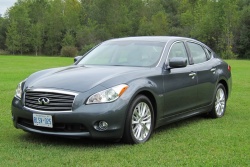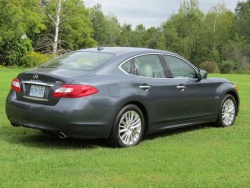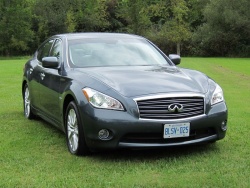 2012 Infiniti M35h. Click image to enlarge |
|
More Infiniti M35h reviews on Autos.ca
Manufacturer’s web site |
Review and photos by Jil McIntosh
Photo Gallery:
2012 Infiniti M35h
Originally used to power compact hatchbacks that could be more geeky than truly good, hybrid technology has more recently entered the luxury realm. Such an example is the Infiniti M35h, an all-new model for 2012.
Nissan is no stranger to electrification – there was the Altima Hybrid even before the battery-powered Leaf – and bringing it to its premium division is a natural. So while the M35h carries a 3.5-litre V6 as its name suggests, it also has an electric motor and lithium-ion battery. The gasoline engine produces 302 horsepower, along with 258 lb-ft of torque, but when the electric motor is added in, the combination can produce up to 360 horses, and the motor can kick in 199 lb.-ft. of torque.
That’s more horsepower than the gasoline-only M37, which coaxes 330 ponies out of its 3.7-litre V6, although not as much as the M56, which has 420 horses on tap out of its 5.6-litre V8. The M35h outshines both of them on fuel economy. You’ll pay for that, though: while the M37 starts at $52,400, and the least-expensive M56 is $66,200, the hybrid rings in at $67,300, albeit in a single, fully-loaded trim line. Saving the planet isn’t always the cheapest proposition.
 2012 Infiniti M35h. Click image to enlarge |
Unlike its conventional M37 and M56 siblings, which can be ordered with all-wheel drive, the M35h only powers its rear wheels. And while Nissan puts CVTs into many of its models, this one uses a conventional seven-speed automatic transmission. I don’t mind giving up any extra mileage in return for the more premium feel of a unit with gears. Like most other hybrids, the M35h can run on gasoline, electricity or a combination of the two, but thanks in part to its energy-dense lithium-ion battery, it can stay on electric power at higher speeds, depending on driving conditions. The company says it can do this up to 100 km/h, but I was at 115 km/h at one point when it switched over and cruised on battery power alone. It’s not a plug-in, though; the battery recharges with regenerative braking.
The electric motor’s torque gives the M35h considerable acceleration power, and if you’re willing to sacrifice a few squirts of fuel, it feels similar to a V8 if you put your foot firmly down on the long pedal. An “Eco” driving mode can be accessed via a dial on the dash (which also includes Sport and Snow modes), but if you’re like me, you’ll try it once and then forget it exists. It’s actually unpleasant and gives the engine sluggish response to throttle input. It also activates the “Eco pedal,” a Nissan-exclusive invention that should also have been left in the box. When it’s on, the pedal will push back against your foot if it thinks you’re too aggressive on the throttle. Rather than make me fuel-conscious, it was just annoying. In case you’re wondering, the pressure is minor and you can put your foot down past it if you need to accelerate.
 2012 Infiniti M35h. Click image to enlarge |
Even with a few trips in Sport mode, I got pretty decent mileage for a full-size car that tips the scale at 1,883 kilograms. Against published figures of 7.5 L/100 km (38 mpg Imp) in the city and 6.1 (46) on the highway, I averaged 7.9 (36) in combined driving. By comparison, the conventional M37 rates 11.4/7.6 (25/37). Premium fuel is recommended.
Over the years, the Infiniti M has morphed from forgettable into a solid, easygoing machine that’s far more luxury than sport, along the lines of competitors such as Mercedes-Benz’s E-Class. Other than when the Eco mode is on, the driving experience is exemplary: acceleration is linear and the system switches between gasoline and electric power seamlessly. The electro-hydraulic steering is nicely weighted, if far more lenient Lexus-like than Audi-style sharp sportiness. The chassis is similarly tuned to be pliable, although it’s never floaty or wobbly. I didn’t care for the brakes, though. The pedal is too firm, with that harsh earlier-hybrid brake feel that most automakers have overcome, and it’s hard to regulate.











